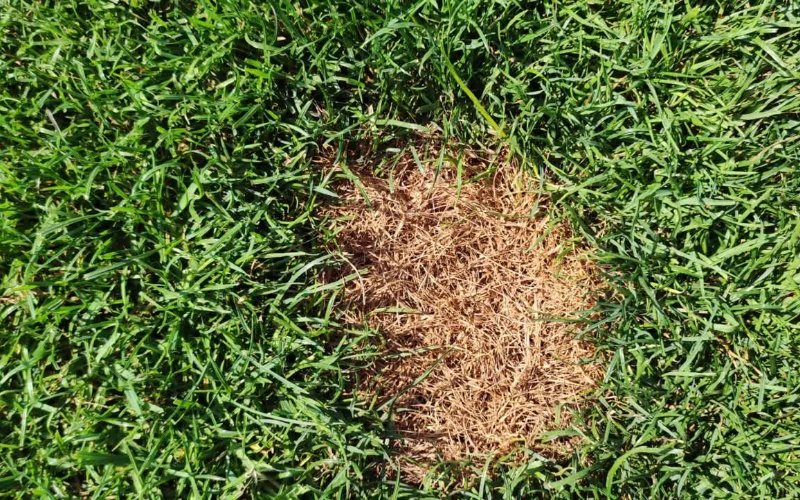There are two causes of damage that many lawn owners dread dealing with: grubs and fungus. Both of these conditions can strike seemingly at random and getting rid of either pest can take some drastic measures. Worse, most of the time the damage isn’t noticed until it’s too late to save large portions of a lawn. Below you can learn how to definitively diagnose if either one of these problems is causing damage to your lawn. Once you know which problem you have, you can develop an appropriate treatment plan.

Tell-Tale Signs of Lawn Grub Damage
There are 5 main signs of grub damage in lawns. In short, these signs include thinning grass and small, circular or irregular brown patches not caused by dehydration or shade. If you remember spotting many beetles in the previous season, this is also an indicator of too many grubs.
Grub predators like moles, skunks, and armadillos are also often found around a heavily-infested lawn. Finally, loose grass or grass that is completely detached is one of the easiest and most dreaded signs of lawn damage caused by grubs.
What About Fungal Damage – What Does It Look Like?
Fungal damage looks like your lawn is healthier than ever- in places. Or it looks like things are drying up, even when they’re sopping wet. Fungal damage could even look like someone sifted flour onto your lawn overnight.
While fungal damage looks like all of these different things, it always smells the same. Fungal damage to a lawn smells like mold and, as it progresses, rot. This is the easiest way to tell fungal damage from any other type of lawn pest or disease.
Once a fungus gets going in a lawn, you may start to see even more symptoms. Most common are brown, yellow, or reddish patches that grow in size by the day. The grass around the edges of these patches may look like it’s covered in powder or be dark and slimy, like spilled oil. Fungus can afflict a lawn in hot, dry weather as well as wet, cool weather.
Grub Damage vs Fungus – How to Definitely Tell
Lawn grub damage looks very different from fungal damage when you pay attention to the details. It also smells different. In the section above you learned that lawn grub damage vs fungus or fungal damage has one key difference: smell. If you smell mold and rot, fungus is involved in some way. If you are unable to smell this, it could still be there but is less likely to be the primary culprit of your lawn damage.
Beyond smell, it’s important to do a grub count to prove or rule out a grub infestation. A grub count is a simple thing to do. All you need are gloves and a sharp spade. Another type of shovel can be substituted for the spade. A hand rake can be helpful.
How to Do a Grub Count
First, cut out a section of lawn, 1-foot square and about 2 inches deep. Turn this section over and use your fingers or the hand rake to “comb” out any grubs that are tangled in the grass roots. Next, comb through the top inch or two of soil that was originally beneath this section of lawn and remove any grubs. Count all the grubs you have found.
Do you have 9 or more grubs? That’s a problem and a good sign that your lawn has too many grubs and the damage you’re seeing is likely due to this. 6 or fewer grubs? It is unlikely that you have a problematic number of grubs living under your lawn. Repeat this test in 1 or two separate areas of your lawn from the first test square to get a solid, average grub count.
Beyond Counting Grubs
Beyond the number of grubs found in the soil, this is a good test to determine if you have fungal damage, too. What do the roots of your grass look like? Fungal infections, if not of the powdery variety, will often turn grass roots to mush and produce a strong, rotten smell. If you see any of these signs, you likely have a fungal infection.
While rare, as grubs will move away from a fungal infection, you could have an infestation of grubs and fungus at the same time. In a case like this, you may have a high grub count and all of the symptoms of a fungal infection, including brown patches, soggy soil, and rotten roots. When this happens, it’s important to treat both diseases, though you will need to be careful not to overlap certain insecticides and fungicides. Doing so may render one of the poisons inert or produce another unintended result.


Leave a Reply